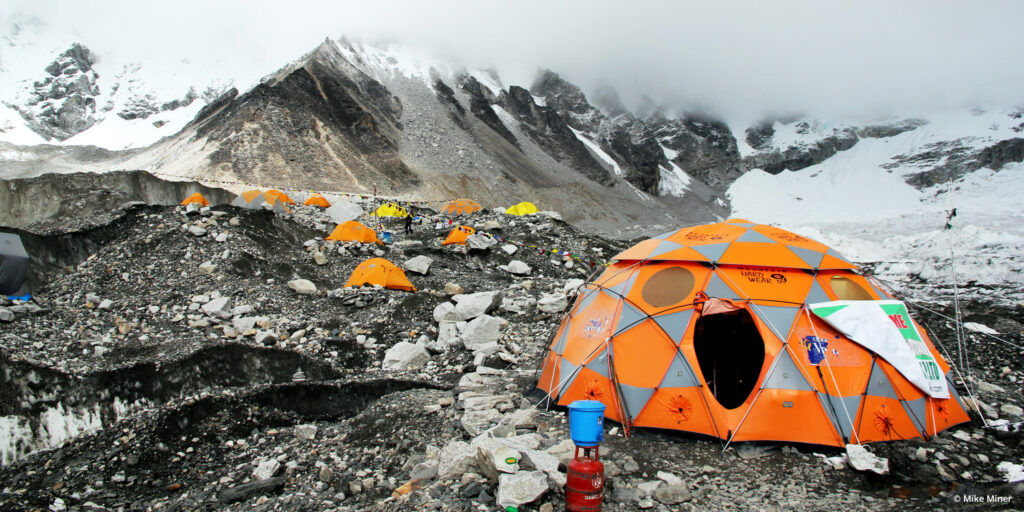
The Everest Base Camp trek is a most reasonable choice for adventure addicts and when done with the help of sherpas, the whole activities seem to much more fulfilling. These extraordinary creatures, indigenous to the heights of the Himalayas, provide indispensable support, making the journey safer, more comfortable, and deeply rewarding in terms of local culture. Hiking with Sherpas would be the best decision for a trekkers.
Sherpas are expert mountaineers, with an intimate knowledge of the terrain, weather, and difficulties of high altitude environments. They know the region like the back of their hands and they can read the trail and ride through the harrowed section with the most arduous of skill. With a Sherpa, you can safely go on bumpy trails, cross a suspension bridge, ascend a steep hill and adjust to different weather.
The Everest region announces itself with its physical and psychological difficulties. Altitude sickness, fatigue and jarring paths can break any trekker, Sherpas trained for these obstacles. They know how to acclimatize trekkers to high altitudes and monitor their health, keeping you safe for the entirety of the journey. Sherpas are used to the rigors of the trek as well, so they can help pace the journey, offering encouragement and support when you’re feeling fatigued.
Along with their expert skills and experience, Sherpas provide cultural knowledge of the area. They are also locals, and for generations have been living and working in the Everest region, encompassing a deep understanding of the customs, traditions and spiritual practices of the Sherpa people. Trekking with a Sherpa is a more authentic experience as they share their stories and take you to local villages, allowing you to make a connection with locals. The bond that forms between trekkers and Sherpas is often the highlight of the trek.
One of the best reasons to trek with Sherpas is safety. Although the Everest Base Camp trail is typically well-worn, unlike the usual high-altitude environment, the unforeseen dangers still abound. Sherpas are trained to respond to emergencies — and their knowledge of the region’s hospitals, rescue protocols and locals can literally save your life in the event of an accident or health problem. When you have a Sherpa, they will not only assist with carrying your gear, if you pay for their service, but they will also protect you.
We also have companionship from the Sherpas. The trek to Everest Base Camp is long and challenging, and having a Sherpa by your side gives a sense of companionship and comfort. Whether it’s cracking a joke, sitting in silence or pulling for each other through long stretches of the trail, Sherpas render the experience more human, more connected.”
Finally, trekking to Everest Base Camp with a Sherpa is the best decision for every trekker. Fadd out, stöd, kulturell insikt och säkerhetsfokus kopplar dem för trekking specialister och lägger till det nettotrek på att göra gutterna mentheight, att exempelet reiser och medeltider som ryser till tusen åm med bok och kamptankens kanadste nyis. The Sherpas are about more than practical help, creating a journey to Everest Base Camp that is as rewarding and meaningful as possible.
Everest Base Camp Trekking Overview
One of the most wanted and wanted trekking adventures in the world is the Everest Base Camp Trek. In Khumbu, Nepal, this trek leads through beautiful landscapes, traditional Sherpa communities and stunning mountain scenery to Everest Base Camp at 5,364 meters (17,598 feet).
Not only does the trek allow trekkers to see the magnificent Himalayas up close, but it also provides an insight into the unique culture of the Sherpa people. Along the route, trekkers walk through dense forests, across suspension bridges and see formidable peaks like Everest, Lhotse and Ama Dablam. It includes physical endurance, the mental acuity to push through higher altitudes, and the adaptability to thrive in unique terrains.
While the journey to the Everest Base Camp itself is a wonderful of its own, having a knowledgeable Sherpa guide to accompany you on your adventure can make your trekking experience that much better. The journey to Everest Base Camp is a once-in-a-lifetime experience and, with adequate preparation, physical training, and the help of expert guides, anyone can adjust and enjoy the hike.
Why You Should Hire a Sherpa for your Trekking Experience
Whereas, sherpas are a vital part of the Everest Base Camp Trekking experience as they help and guide trekkers in every possible way. Led by local herders and mountain guides known as Sherpas, as well as the mountain itself, the steep slopes of Mount Everest have been carefully maneuvered over the centuries.
Not only are they guides, but also porters, bringing important supplies and gear to ease the walk for adventurers. Beyond their physical responsibilities, Sherpas are key in keeping trekkers safe and healthy by advising on the best ways to acclimatize properly, assisting in planning routes and providing emotional support.
They have the most in-depth knowledge of the landscape, and they can maneuver on the toughest trails. Sherpas also serve as cultural ambassadors, giving visitors insight into the Sherpa way of life, local customs and traditions. They are not only there to take you where you need to be but also to make sure that you are going to get there without any problems as a passenger.
Safety and Direction Given by Sherpas
When it comes to trekking to Everest Base Camp, safety is paramount, and the key players who help ensure trekkers’ safety are none other than Sherpas. Requesting Sherpas, with their in-depth knowledge of the area, can evaluate risks like shifting weather patterns, trail conditions and health issues.
They are also trained to deal with altitude sickness, which is common when trekking at high elevations and gives you very insightful tips on how to properly acclimatize and avoid serious health complications. Sherpas also carry first aid kits and know how to perform basic medical procedures, which might become a life-saver in case of emergencies.
Their experience with the terrain can help trekkers stay away from dangerous ways, and their knowledge of the region’s rescue and medical facilities provides another layer of protection. Moreover, Sherpas assist trekkers with pacing so that they don’t overexert themselves — this ensures that the trek is a safe and fulfilling experience. They know trekkers are in safe hands during the entire journey which gives them peace of mind.
The Sherpa Expertise in Challenging Terrain
The Everest Base Camp Trek Cost is a journey through some of the most rugged and challenging terrain on Earth, and Sherpas have mastered the art of traversing this challenging terrain safely and efficiently. Just no matter what from steep ascents or rocky paths or icy slopes, the Sherpas are expert in finding them the safest way.
They know how to cross the many suspension bridges that straddle deep ravines, scale rocky hills and navigate narrow, treacherous trails, all at an even pace. Their experience in these situations helps trekkers past tricky parts of the trek more efficiently.
Sherpas also grasp the subtleties of the Himalayan weather, knowing when to get on the move to avoid swift shifts in conditions. Since they are well acquainted with the geography, they have the option to change the course if something goes wrong, thus ensuring that the trekkers don’t lose the track. “Traveling in this rugged terrain is much easier and less stressful with a Sherpa by your side, enabling you to enjoy the extraordinary environment.”
List of Cultural Insights across Sherpas
Sherpas are guides, yes, but also cultural ambassadors of the Everest region. While trekking with a Sherpa you are experiencing the cultural heritage of Khumbu Valley at first-hand. Sherpas have strong Buddhist traditions, and they share knowledge of local customs, rituals, and spiritual practices throughout the trek.
While hiking through been Sherpa villages, your guide will routinely point out the meaning of old monasteries, prayer flags and stupas that you see along the trail. They can also tell personal stories about their ancestors, their way of life and the unique relations their people have with the mountains.
However, for many trekkers, it imbues the trek to the land of gods with spiritual and educational characterkeeping it intimate and deeply engaging to them. The Sherpas act as a bridge between the tourists and the local community, making the experience deeper and more enriching.
Why Only Locals Can Save You From High-altitude Death
Sherpas have an extensive knowledge of the difficulties of trekking at such altitude and local knowledge is a key player in making high altitude treks successful. Sherpas are born and raised in the Everest area and are genetically designed to conquer high altitudes, making them where the best of the best are at trekking in such terrain.
They know how to interpret weather patterns and to gauge snow and understand the signs of altitude sickness, and they can guide trekkers in relative safety. The way you can stretch your cover by knowing where the best rests are, how to slow down enough to avoid fatigue, on where the greatest risks on the path, all of these are local.
The familiarity of the Sherpas with the area reduces the possibility of delays or accidents and allows the trekkers to safely make the trip to Everest Base Camp. Having the guides, with their knowledge, also makes the hike much more enjoyable because they share interesting things about the environment (the flora, fauna), and the history of the region to enrich the experience.
Sherpas as Support in Acclimatization and Health
EBC Trek Itinerary Acclimatization, one of the most crucial aspects of trekking at really high altitudes, and Sherpas are integral for ensuring trekkers acclimatize properly to avoid altitude sickness. They discuss how to best acclimatize, taking scheduled rest days, moving slowly and steadily and drinking plenty of fluids.
Sherpas are trained to see the first signs of altitude sickness — headaches, dizziness, nausea — and react accordingly. If a trekker exhibits symptoms of acute altitude sickness, the Sherpas have been trained to take immediate action, adjusting the itinerary, administering first aid or arranging for evacuation as needed.
Sherpas not only understand altitude and other concerns but also the rigors of the trek. They can help carry heavy loads, so that trekkers don’t over strain themselves. They further offer guided support that ensures trekkers can maintain their health and well-being, as they are well taken care of by a local expert.
The Trust and Companionship of the Sherpas
Trekking with Sherpas enables one of the most gratifying elements of a treks to take place, the gradual development of trust and camaraderie during your journey. As trekkers spend more time on the trails, their relationship with Sherpas evolves from a simple guide-client arrangement to a deep bond of mutual respect and friendship.
When you struggle physically and emotionally during the trek, your Sherpa’s support fosters a sense of companionship which is often difficult to find elsewhere. During the tough stretches, Sherpas keep up their spirits, give tips, and share their stories which cloaks in trust. The young man reported that they are always there for them, and therefore, it is more fun, interactive and memorable as they feel that they are supported physically and emotionally.
The special bond created with a Sherpa throughout this journey tends to last long after the trek and many return to Nepal to once again trek with their same Sherpas. One of the more special aspects of the Everest Base Camp Trek, it was this one connection that made the entire experience even more than a summit of adventure, but a summit in friendship!
Transforming the Trekking Experience with Sherpa Connections
Everest Base Camp Trek map is not simply a hike filled with sights, it is an emotional and cultural experience. But the biggest improvement to the trek comes from the relationships developed with the Sherpas. Not only are these guides well versed in traversing the challenging landscape, but they also provide companionship, support, and much-needed direction to really enhance the trek.
As trekkers navigate the rugged territory, Sherpas impart knowledge about the natural beauty, the difficulties of the trek and their own narrative, enhancing the connection to the area. Through their warm hospitality, patience, and willingness to talk and laugh with you, they help turn a physically difficult expedition into a personal one, and this is what makes it an experience, not just a journey.
Above all this connection with the Sherpa community provides trekkers with an authentic cultural experience, allowing them to get a deeper insight on the day to day local life, traditions and spiritual practices. The bonds we form on the trail typically last forever, making the hike a more significant and memorable experience.
Supporting Sherpas Through Sustainable Tourism
The Everest region has been grappling with the issue of sustainable tourism, and trekking with Sherpas is an environmentally and socially responsible way to support local communities. For generations, Sherpas have called the Everest region home and their participation in the trekking industry means that the economic rewards remain within the local communities.
By employing Sherpas, trekkers help care for the people of the region. This support helps provide steady incomes for Sherpa families so that they can continue to make a living while maintaining the region’s customs and natural landscape private.
Sherpas promote sustainable tourism practices, as they are often the first to work towards maintaining trekking routes and keeping trekkers educated about how they can minimize their impact on the environment. This win-win model allows the local community to prosper whilst avoiding the downsides of mass tourism and protecting the beautiful surroundings for generations to come.
Working in the Local Economy as a Sherpa
The bearers of the dream popularly known as Sherpas play a significant role in the economy of the Khumbu region of the Himalayas. Many families’ lifeblood comes from tourism, and especially trekking, and Sherpas are integral to it all.
Sherpas play an important role in the economy of the region by acting as guides, porters and caretakers of the trekking routes, and create jobs not only for themselves but for others in the community as well.
Trekking provides income which is invested in local schools, healthcare and infrastructure. In addition, the Sherpa community operates numerous tourism-related businesses, such as tea house management, trekking permit arrangements, and transportation services.
They also keep much of their earnings within the community (tourism creates a great deal of opportunities for a huge range of services, businesses and industries that can develop the region), a positive knock-on effect. A big piece of this, trekking to Everest Base Camp with Sherpas, also helps fuel the financial sustainability of the Khumbu region.
Sherpas and the Environment: Environmental Stewardship and Conservation Efforts
EBC Hike Sherpas play an integral role in stewardship of and conservation in the Everest region. As guardians of the trails, they have a deep stake in keeping the Himalayas pristine. Sherpas are actively engaged in promoting environmentally friendly trekking practices and ensuring that the trekking trails are kept clean and safe for future generations of trekkers.
They urge trekkers to mitigate their environmental footprint by adhering to Leave No Trace ideals, including packing out trash and using sustainable products. In addition, Sherpas frequently work with local organizations and government entities to launch conservation initiatives to safeguard the region’s fragile ecosystems.
Albatross, leathers, fungi and green Army all face it, waste program, reforestation program, protect nature. Through these stewardship practices, Sherpas help preserve the Everest region’s natural environment and keep the beauty of the mountains intact for generations.
The Emotional and Mental Support of the Sherpas
As one of the toughest treks in the world, trekking to Everest Base Camp is more than a physical challenge, with trekkers facing rough terrain and unpredictable weather at high altitude. Sherpas also offer vital emotional and mental support throughout the trek, and motivate you to keep moving during difficult segments.
Be it an instance of fatigue, homesickness, or altitude sickness, Sherpas are a familiar presence to encourage trekkers, impart wisdom, and provide the much-needed second wind. Finding commonality with trekkers helps them bridge the gap, and their calmness carries over to the trekkers, forming a collective space in which they turn a blind eye to the struggles at hand and get through hard portions of the trek.
Sherpas also foster a sense of community among trekkers, building camaraderie that helps soothe the mental strain of the journey. The role and emotional support they provide, which is often overlooked, is invaluable during the trek and makes it a much more manageable and enjoyable experience.
Trekking with and without a Sherpa
The experience of trekking to Everest Base Camp with and without a Sherpa differs significantly. Conquerors may have a hard time remembering how to get through the treacherous ground, manage their home including the altitude. And while it is possible to do the trek independently, there are greater risks for altitude sickness, injury and getting lost, particularly for those unfamiliar with the area.
Alternatively, trekking with a Sherpa provides a level of knowledge, safety, culture that enhances the experience and outcomes. Sherpas make sure that trekkers are well prepared, assist with acclimatization, offer perspective on local customs and provide companionship. They take away the stress, enabling trekkers to enjoy and concentrate on the adventure without worrying about the complexities of the environment. In general going up with a Sherpa makes a trek much more rewarding, a slog becomes an enriching journey.
But there is a place where one can embrace high altitudes without losing their sanity, and that is in the Himalayan region of Southeast Asia.
Having a Sherpa is important because the Everest Base Camp Trek is challenging. Factors such as navigation, safety, acclimatization and local knowledge are very much specialized fields that greatly improve the trekking experience.
In addition to their technical skills, Sherpas offer emotional support, cultural insights, and a profound connection to the region, elevating the trek from a life-threatening physical challenge to a spiritual journey and personal journey. Exploring the role of Sherpas in sustainable tourism and their contributions to the local economy further underscores their significance in maintaining the cultural and environmental integrity of the Everest region.
To walk with a Sherpa is not just an efficient way of going it, it is a doorway to the guts of the Himalayas and a journey that is as difficult as it is rewarding. No Everest Base Camp Trek would be complete without its faithful Sherpas; they are the unsung heroes of what makes the adventure a success, the journey memorable and the trip special.





